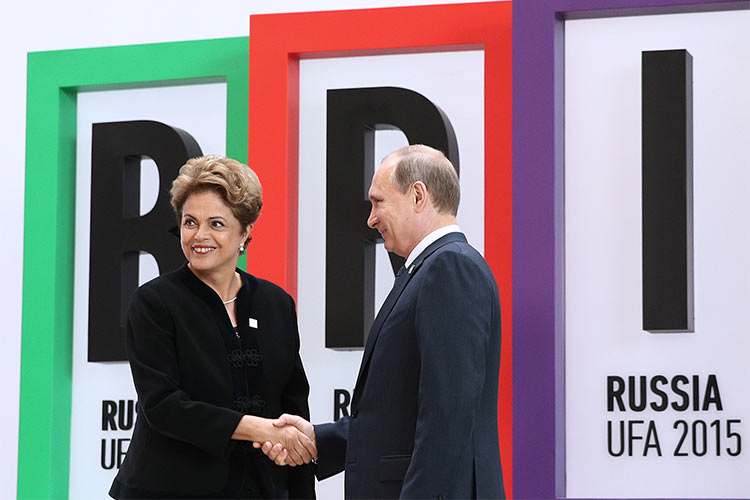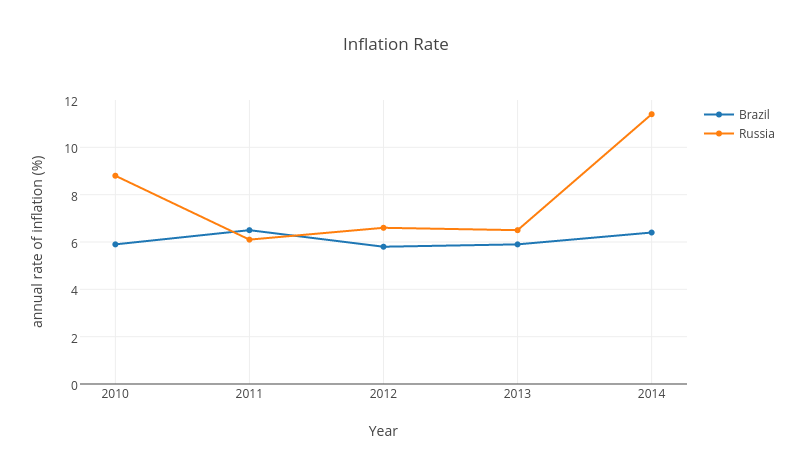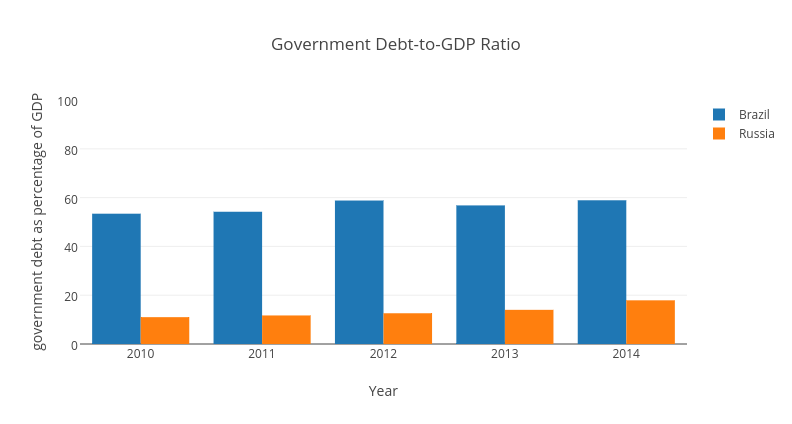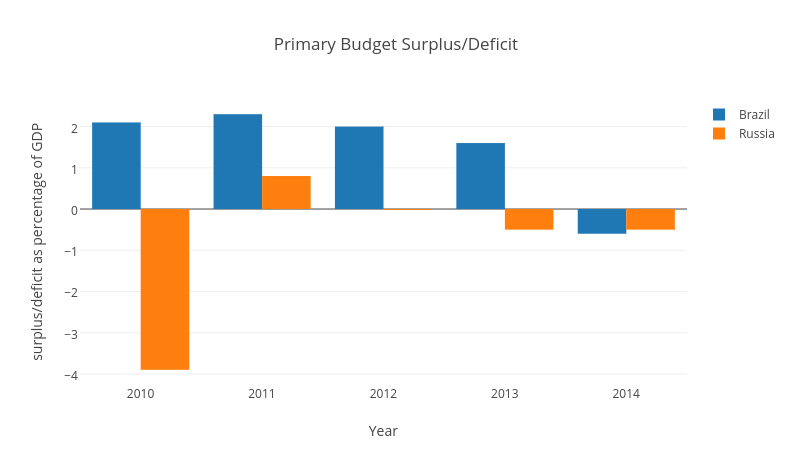The BRIC nations have lost some of their luster recently, due to the crash in commodity prices and chronic low demand in the West. How does the economic situation in Russia compare to that in Brazil, India and China? In part one of a three-part series, IMR analyst Ezekiel Pfeifer compares Russia to Brazil, where the economy is strikingly similar to that of Russia but where the political system sets the country apart.

Even though Russia’s President Vladimir Putin (right) and Brazil’s President Dilma Rousseff belong to the same elite club of BRIC countries, the contrast between the two leaders and the way they manage their countries could not be starker. Photo: Stanislav Krasilnikov / TASS
The economies of the original four BRIC countries—Brazil, Russia, India, and China—have begun to run low on fuel for growth amid a worldwide slump in commodity prices and sluggish gains in the West. Russia’s current crisis had its own unique triggers, such as the cold snap in relations with the U.S. and Europe, but the country also shares certain key attributes with its BRIC counterparts. The Kremlin has made it a priority to associate itself with these nations, citing their shared status as rising powers—but how similar are they really? In order to understand better the obstacles facing Russia and how they compare to those of its supposed peers, IMR will examine the situations in Brazil, India, and China in a three-part series.
In recent months, Brazilian President Dilma Rousseff has become inseparable in the public eye from a massive corruption scandal at state oil company Petrobras, the board of which she led in the late 2000s. But Rousseff was not always so closely linked to mega oil money and the Brazilian government. In fact, she got her start in politics in the 1960s as a left-wing activist who opposed Brazil’s military dictatorship. She was even imprisoned for three years in the early 1970s for her activism, undergoing torture that included electric shocks.
Contrast Rousseff’s story with that of Vladimir Putin and one can discern a key difference between modern-day Brazil and Russia, which have similar economies that have struggled lately amid a collapse in world commodity prices. Instead of being an anti-government activist in his youth, Putin was a proud Soviet patriot, joining the KGB as soon as he graduated from university in 1975. Far from speaking out against the crimes of the Soviet regime, Putin was among the ranks of the secret service, helping to spy for the government. His colleagues were responsible for locking away dissidents—people like Rousseff in her youth in Brazil.
The fact that Rousseff can wear her former imprisonment as a badge of honor points to Brazil’s swift evolution as a country, from dictatorship to burgeoning democracy, while Putin’s KGB pedigree is a reminder of the degree to which Russia remains rooted to its totalitarian past. Perhaps in part because Brazil saw such dramatic and frequent change over the last century, the democratic institutions forged in that fire are miles ahead of those in Russia. As a result, Brazil may be better-positioned to emerge strong from the current worldwide downturn among emerging nations.
Looking at the fundamentals of Russia’s and Brazil’s economies, they appear to be close relatives, if not exactly twins. Like Russia, Brazil is highly dependent on income from exports of raw materials (such as oil, iron, sugar, and coffee), which represented about 50 percent of the country’s total exports in 2014. The situation is even more extreme in Russia, where crude oil, natural gas, and petroleum products alone account for almost 70 percent of exports. Both countries have battled high inflation in recent years: prices in Brazil rose annually by an average of over 6 percent from 2010 to 2014, and the current rate has spiked to about 9.5 percent, while inflation in Russia averaged almost 8 percent from 2010 to 2014 and has surged to almost 16 percent today. But the high inflation has not been accompanied in either country by impressive economic growth. Brazil’s economy expanded at an average of 3.2 percent from 2010 to 2014, while Russia’s grew an average of 2.8 percent a year over the same period.


Sources: World Bank, Tradingeconomics.com and others.
Per capita GDP in the two countries is comparable, standing at $11,612 in Brazil and $12,735 in Russia in 2014. Both countries’ currencies have cratered over the last year—the Brazilian real has lost 69 percent of its value over the last 12 months, while Russia’s ruble has dropped 72 percent—as the oil-price supercycle has headed toward a low. These currency devaluations have led the two economies to begin shifting away from a growth model based on consumption.
On Sept. 10, Brazil joined Russia as a member of a club no one wants to be in when Standard & Poor’s lowered its credit rating to junk status. (Russia received the same downgrade from S&P in January, then from Moody’s in February.) But the reasons for the two downgrades were largely different. In Brazil’s case, investors are concerned about the country’s expanding budget deficit and considerable debt load. The country’s primary budget shortfall—meaning the deficit before including interest payments on debt—was 0.6 percent of GDP in 2014 after the country ran a primary surplus for years, and over the 12 months to June 2015 the primary deficit stood at 0.8 percent of GDP. These numbers mask an even worse deficit when debt payments are added in: the total 2014 budget deficit equaled 7 percent of GDP, the worst mark in a decade. Brazil’s cost of borrowing has skyrocketed as investors force its bond yields upward, to the point that a Brazilian government bond maturing in 2023 has a similar yield to one from neighboring Bolivia, the poorest nation in South America. Brazil’s debt-to-GDP ratio stood at almost 59 percent in 2014, compared to Russia’s much lower 18 percent.


Sources: World Bank, Tradingeconomics.com and others.
Another major reason for the credit downgrade was the severe instability in Brazil’s government, which has become gridlocked amid a wide-ranging corruption investigation at Petrobras, the country’s national oil producer. (Incidentally, just as Brazil has more debt than Russia, Petrobras has a much larger debt load than its Russian cousins Rosneft and Gazprom: Petrobras owes about $134 billion—the most debt of any world oil major—while Rosneft owes $43 billion and Gazprom has a total of around $25 billion in borrowings.) The investigation is examining alleged corruption at Petrobras in the 2000s, a time when Rousseff chaired the board of the company, and the inquiry has already targeted one of the country’s top lawmakers. It may even reach all the way to Rousseff herself. Amid all the finger-pointing and jockeying for position among the governing elites, the process of reforming the country’s inflexible labor market, bloated bureaucracy, and high corporate taxes has been held up.
The result has been Rousseff’s approval rating plummeting to 8 percent, a low unheard of in Russia’s Putin era, and street protests that drew around 600,000 people across the country in August, 500,000 in April, and a stunning 1.7 million in March. Compare those numbers to the turnout at Russia’s dramatic demonstrations of winter 2011-12, which topped out at around 100,000 people and averaged less than half that number. For Putin, displays of dissent like those in Brazil are unacceptable: when signs of disapproval begin to appear, the Kremlin turns up the volume on its propaganda machine (masked as TV news), whereas the Brazilian media environment has gradually become more democratic instead of being consolidated in state hands as in Russia.
Similarly, the “power vertical” built by Putin over his 15 years in power functions with little friction: whenever the Kremlin wants a law passed, all it has to do is to say the word, since virtually every lawmaker is in bed with it. But it also acts almost exclusively at Putin’s behest, instead of functioning with a set of checks and balances. In Brazil, by contrast, a judge and a team of prosecutors (one of whom is Harvard-educated) have been allowed to work on the case probing corruption at Petrobras. In modern Russia, it is almost impossible to imagine investigators toppling the management of Rosneft or Gazprom, let alone targeting lawmakers or Cabinet members, despite the fact that most observers agree that fraud is rampant at the two state behemoths. (It should be said that, despite these differences, the governments of Russia and Brazil are quite friendly with each other. Just recently, on Sept. 15, they co-hosted a forum in Moscow devoted to bilateral business ties, for instance—but trade and investment between them remains limited.)
The Russian government’s top-down style makes it easy for Putin to get legislation passed when he wants to do so—but it is anyone’s guess what Putin will decide to do at any given moment. Under his system, there is a much greater likelihood of unpredictable actions, such as Russia’s sudden invasion of Crimea in March 2014 and subsequent support of rebels in eastern Ukraine. Those aggressive gambits led directly to the West enacting sanctions against Russia, sanctions that are contributing to the country’s significant recession—and that recession may get worse still. In downgrading Russia’s debt in January, S&P cited this current major downturn, exacerbated by the depressed price of oil, and murky future outlook for the country’s economy, as opposed to turmoil or gridlock in the government. Like Brazil, Russia also has dysfunctional labor regulations, oversized government payrolls, and an enormous state role in the economy, not to mention growing fiscal issues of its own, and these factors almost certainly contributed to its credit downgrade as well—especially since reforms to fix these issues are not in sight.
The two countries differ in certain other key areas of fiscal and economic health. Brazil’s military spending, for example, is far below that of Russia: Brazil spent $31.7 billion on defense in 2014, or 1.4 percent of GDP, compared to Russia’s approximately $84.5 billion, or 4.5 percent of GDP. In the first six months of 2015, Russia’s spending rose to 5.6 percent of GDP, presumably due to the conflict in Ukraine and Russia’s more assertive military positioning in Europe. In terms of economic development, Russia’s military spending is a considerable burden, putting Brazil, with its less ambitious geopolitical goals, at an advantage. On an economy-wide scale, Russia is better off when it comes to its current account, which encompasses the country’s balance of trade and loans vs. debts: Russia had a current account surplus of $19.2 billion in the second quarter of 2015, while Brazil had a current account deficit of $12.8 billion in the second quarter. Brazil has consistently had a current account deficit for the last five years, whereas Russia has run a surplus for almost the entire last 15 years.
Current government bond yields maturing in 2025 indicate that investors think Brazil is a riskier bet than Russia, with Brazil’s yield above 14 percent and Russia’s below 12 percent. In theory, this is a long-term estimation of the two countries’ fiscal outlooks. But yields fluctuate intensely as bonds are bought and sold, and investors react to every snippet of daily news. A more accurate view of the two nations’ futures may lie in studying their government institutions, which in Brazil are stronger but face barriers to action, while in Russia they are utterly dependent on the executive branch but can take action quickly when Putin wants them to.
This difference is summed up well by recent comments of a Brazilian banker to FT: “It is going to be a very slow recovery, with very little growth,” the banker said. “... [But] I don’t see any radical populists in the wings; that’s good. On the other hand, Dilma does not have the mandate to implement the liberalizing reforms that Brazil so desperately needs.” Most observers believe that Russia’s recovery will be equally slow and with low growth. But Putin, unlike Rousseff, does not have his hands tied by politics: he can do whatever he wants, more or less, without needing to worry about a mandate. If he decides to pursue a reform agenda, Russia may pull ahead of Brazil. In the long run, however—especially if major turmoil results from Putin’s eventual departure from the Kremlin—Brazil could end up being more stable and better positioned to succeed.
Follow the links to read part two (India) and part three (China) of the series.

